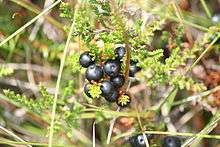Empetrum nigrum
Empetrum nigrum, crowberry, black crowberry, or, in western Alaska, blackberry, is a flowering plant species in the heather family Ericaceae with a near circumboreal distribution in the northern hemisphere.[3] It is also native in the Falkland Islands.[4][5] It is usually dioecious, but there is a bisexual tetraploid subspecies, Empetrum nigrum subsp. hermaphroditum, that occurs in more northerly locations and at higher altitude.[6][7]
| Black crowberry | |
|---|---|
 | |
| Scientific classification | |
| Kingdom: | Plantae |
| Clade: | Tracheophytes |
| Clade: | Angiosperms |
| Clade: | Eudicots |
| Clade: | Asterids |
| Order: | Ericales |
| Family: | Ericaceae |
| Genus: | Empetrum |
| Species: | E. nigrum |
| Binomial name | |
| Empetrum nigrum | |
| Synonyms[2] | |
| |
Evolutionary biologists have explained the striking geographic distribution of crowberries as a result of long-distance migratory birds dispersing seeds from one pole to the other.[8]
The metabolism and photosynthetic parameters of Empetrum can be altered in winter-warming experiments.[9]
Description
The leaves are 3–6 mm (0.12–0.24 in) long, arranged alternately along the stem. The fruits are drupes, 4–6 mm (0.16–0.24 in) wide, usually black or purplish-black but occasionally red.[10]


Subspecies
- Empetrum nigrum subsp. asiaticum (Nakai ex H.Ito) Kuvaev – Korean crowberry[11]
Cultivation and uses
Empetrum nigrum can be grown in acidic soils in shady, moist areas. It can be grown for the edible fruit, as a ground cover,[12] or as an ornamental plant in rock gardens, notably the yellow-foliaged cultivar 'Lucia'. The fruit is high in anthocyanin pigment, and can be used to make a natural food dye.[12]
In subarctic areas, E. nigrum has been a vital addition to the diet of the Inuit and the Sami. The Dena'ina (Tanaina) harvest it for food, sometimes storing in quantity for winter, and like it mixed with lard or oil. The fruits are usually collected in fall, but if not picked they may persist on the plant and can be picked in the spring.
References
- Sp. Pl. 2: 1022. 1753 [1 May 1753] "Plant Name Details for Empetrum nigrum". IPNI. Retrieved 1 December 2009.
- "Empetrum nigrum L." Plants of the World Online. Board of Trustees of the Royal Botanic Gardens, Kew. 2017. Retrieved 11 July 2020.
- Anderberg, Arne. "Den Virtuella Floran, Empetrum nigrum L." Stockholm, Sweden: Naturhistoriska riksmuseet.
- "Empetrum nigrum". Germplasm Resources Information Network (GRIN). Agricultural Research Service (ARS), United States Department of Agriculture (USDA). Retrieved 15 December 2017.
- "Empetrum nigrum L." PLANTS.
- Stace, C. A. (2010) New Flora of the British Isles, 3rd edition. Cambridge University press. ISBN 978-0-521-70772-5. pp. 525.
- Kråkbär (in Swedish)
- Magnus Popp; Virginia Mirré; Christian Brochmann (2011). Peter H. Raven (ed.). "A single Mid-Pleistocene long-distance dispersal by a bird can explain the extreme bipolar disjunction in crowberries". PNAS. Missouri Botanical Garden, St. Louis, Missouri. 108 (16): 6520–6525. doi:10.1073/pnas.1012249108. PMC 3081031. PMID 21402939.
- Bokhorst, S; Bjerke, JW; Davey, MP; Taulavuori, K; Taulavuori, E; Laine, K; Callaghan, TV; Phoenix, GK (2010). "Impacts of extreme winter warming events on plant physiology in a sub-Arctic heath community". Physiologia Plantarum. 140 (2): 128–140. doi:10.1111/j.1399-3054.2010.01386.x.
- "Jepson eFlora: Empetrum nigrum". University and Jepson Herbaria. University of California, Berkeley. Retrieved 15 May 2017.
- English Names for Korean Native Plants (PDF). Pocheon: Korea National Arboretum. 2015. p. 456. ISBN 978-89-97450-98-5. Archived from the original (PDF) on 25 May 2017. Retrieved 24 December 2016 – via Korea Forest Service.
- "Empetrum nigrum - L." Plants for a Future. Retrieved 15 May 2017.
| Wikimedia Commons has media related to Empetrum nigrum. |